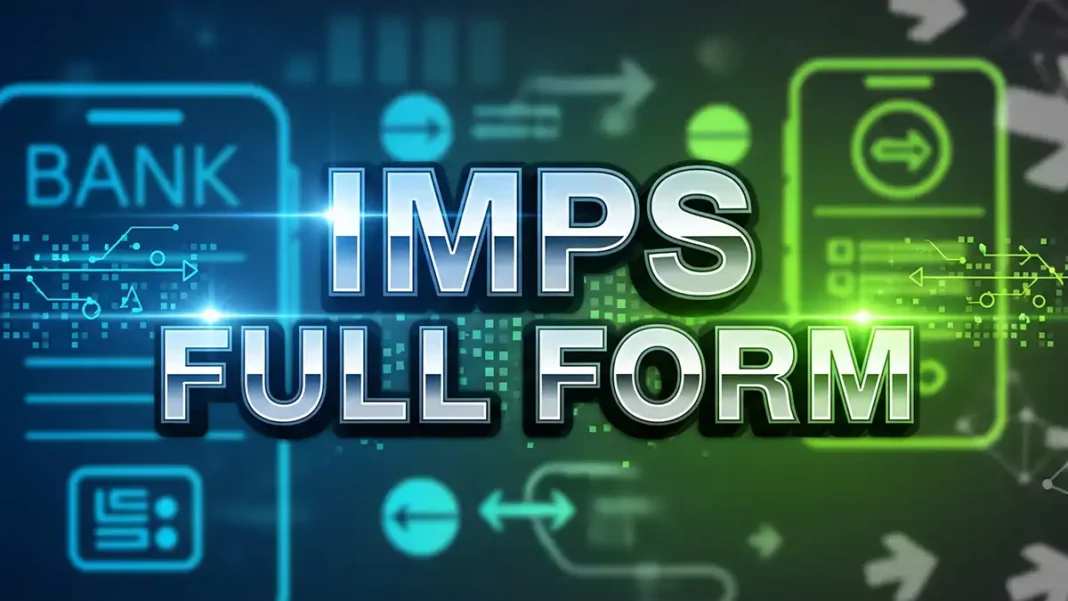The growing digitization of India’s financial industry has altered the manner in which individuals and corporations transfer money. At the heart of this transition is IMPS, an abbreviation that many people meet on a regular basis but may not completely comprehend. Whether you’re an inquisitive banking consumer or a developing business owner, learning the IMPS full form will most likely help you confidently navigate the Indian digital payment ecosystem.
What is IMPS’ Full Form?
Immediate Payment Service is the IMPS full form. This electronic funds transfer technology allows users to instantly send and receive money between Indian banks. The National Payments Corporation of India (NPCI) developed IMPS, which provides flawless, real-time financial transactions 24 hours a day, seven days a week, including weekends and holidays.
IMPS Means: Definition and Purpose
So, what exactly does IMPS include in everyday banking? IMPS stands for the immediate and secure transfer of Indian rupees from one bank account to another via channels such as mobile banking, internet banking, or ATMs. IMPS payments allow users to avoid the significant wait periods and operational hour limits found in previous systems such as NEFT or RTGS. When someone asks “what is IMPS in banking?”, they mean a system designed to make financial transfers as rapid and easy as sending a text message.
IMPS Full Form in Banking: Core Features
IMPS full form in banking isn’t only about speed – it includes a package of features meant to improve user ease and digital financial inclusion:
- 24/7 Availability: 24/7 IMPS is available 24/7, including national holidays and weekends.
- Multi-Channel Accessibility: It is accessible through mobile apps, online banking and ATMs, making it very versatile for a variety of customers.
- High Limits: Users can transmit up to ₹5 lakh per day, with some banks limiting this amount.
- Multiple Transfer Options: Transfers can be made using account information (P2A) or a cellphone number and a unique code (P2P), as detailed further down.
- Secure Transactions: Uses two-step authentication and robust encryption to ensure secure money transfers.
- Low Fees: IMPS transfers are often inexpensive for regular users, with fees ranging from ₹5 to ₹15 per transaction (plus taxes).
- Instant Confirmation: When a payment is successful, both the sender and the recipient are notified right away.
Types of IMPS Transfers: IMPS P2P and P2A
It’s important to recognize what IMPS transfer is and the versatility of IMPS transfer modes when figuring out what it is:
IMPS P2A (Person-to-Account)
- Meaning: Using the recipient’s account number and IFSC code, IMPS P2A (Person-to-Account) refers to a direct transfer from one person’s account to another.
- When to utilize it: After you have the beneficiary’s bank account information on hand.
- Limit: With certain banks, the maximum amount for a transaction is ₹5 lakh.
- IMPS is a very straightforward payment method that is frequently used for formal or higher-value payments.
IMPS P2P (Person-to-Person)
- Meaning: Using the beneficiary’s mobile number and MMID (Mobile Money Identifier), a special seven-digit code that banks provide to customers who utilize mobile banking.
- When to utilize it: Use cases include situations in which the sender has the recipient’s registered mobile number but not their bank account information.
- Limit: Usually set at ₹10,000 per transaction for further protection.
- Transfers made possible by IMPS P2P can be very practical for peer payments or cost splitting.
What is IMPS in Banking? Real-World Impact
The use of IMPS in banking has expanded beyond simple money transfers; it is now the foundation of other digital services. Digital wallets, merchant payments and QR-based transactions have all grown in popularity in India thanks to the IMPS system. Because it provides immediate access to banks, even in rural and small towns, it is a key component of the government’s drive for financial inclusion.
How Does IMPS Work?
Any IMPS transaction proceeds as follows:
- Initiation: The user chooses IMPS, inputs the beneficiary’s information and the amount and logs in (via mobile, online banking, or an ATM).
- Authentication: The user uses the ATM PIN or MPIN/password to authorize the transaction.
- Validation: The bank uses NPCI’s secure payment gateway to route the payment after verifying the information.
- Finalization: The beneficiary’s account is immediately credited with the funds. Transaction alerts are sent to both the sender and the recipient.
IMPS Full Form: Major Advantages
So, IMPS is more than simply another financial acronym:
- Instant Money Movement: No waiting periods, even for huge sums.
- Universal Access: Open to all bank account holders, not just premium banking users.
- Seamless Integration: Supports peer-to-peer, merchant and bill payments, allowing more people to join the digital economy.
- Fail-proof Mechanism: If an IMPS transfer fails, the funds are automatically reversed, reducing user worry.
IMPS Payment Means: Who Uses It and When?
IMPS payment allows anyone with a savings or current account and mobile/internet banking to initiate a transfer. Usage situations include:
- Immediate bill payments
- Sending money to relatives or friends
- Paying vendors immediately
- Managing company payments in real time
Because of its dependability and reach, IMPS is likely to remain a preferred option for millions, even if UPI gains ground with smaller, more frequent retail transactions.
IMPS Security and Customer Protections
IMPS takes security very seriously. Every transaction includes two-factor authentication, strong data encryption and automatic notifications for questionable activity. If something goes wrong, such as a network breakdown, the system ensures that funds are returned to the sender as quickly as possible, usually within hours. This commitment to customer-centric safety is one of the reasons why IMPS is popular and trusted in Indian banking circles.
Conclusion
Understanding the IMPS full form, or Instant Payment Service, is very helpful for anyone looking for a quick, safe and convenient way to transfer money in the quickly changing world of Indian banking. With little effort and expense, IMPS enables you to pay a vendor, send money to family members instantaneously, or settle a payment at midnight. Given its strong security, wide accessibility, and smooth integration with smartphones and online banking, IMPS is probably going to continue to be the foundation of India’s digital economy for many years to come. Knowing what IMPS is in banking gives both individuals and organizations the confidence to manage their everyday financial needs while optimizing convenience and control.
Frequently Asked Questions
Q: What is IMPS Full Form?
A: The full form of IMPS is Immediate Payment Service.
Q: Is IMPS safe?
A: Yes. IMPS uses robust encryption and dual authentication, making transactions extremely secure.
Q: IMPS means what in simple terms?
A: IMPS is a platform that facilitates instantaneous, round-the-clock bank-to-bank transactions. IMPS makes payments quick, secure, and accessible.
Also Read:
How to Write a Cancelled Cheque: Explained
David William comes from an Engineering background, with a specialization in Information Technology. He has a keen interest and expertise in Web Development, Data Analytics, and Research. He trusts in the process of growth through knowledge and hard work.


